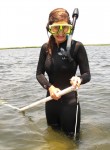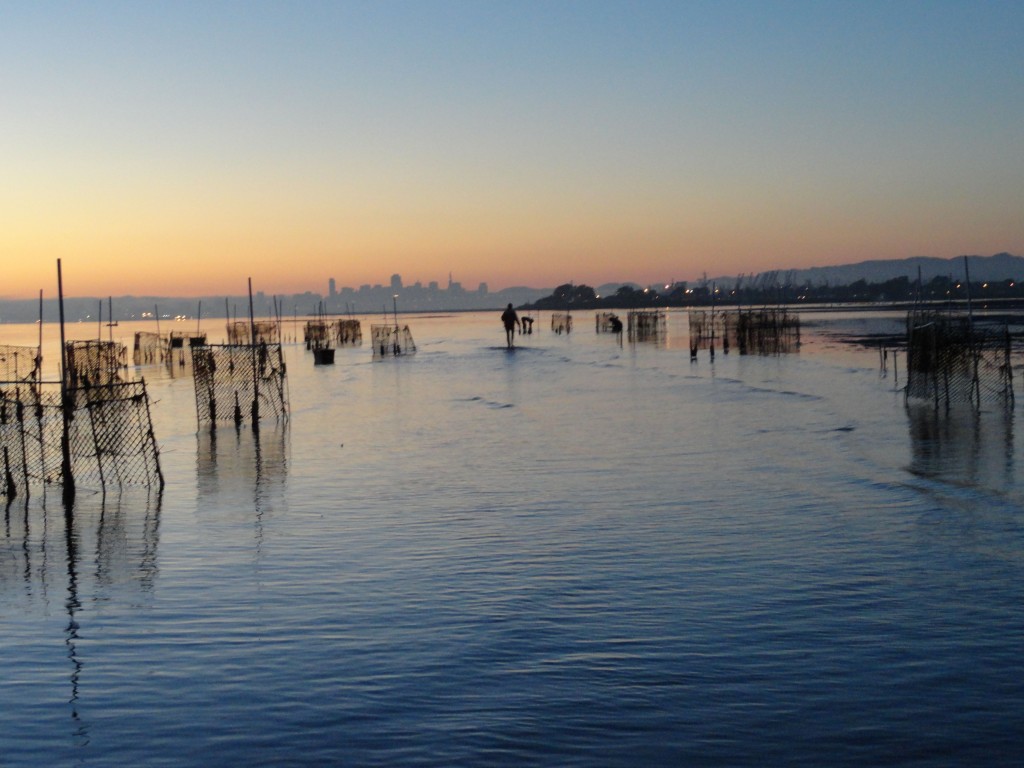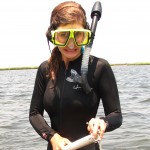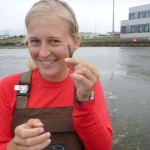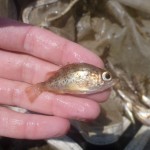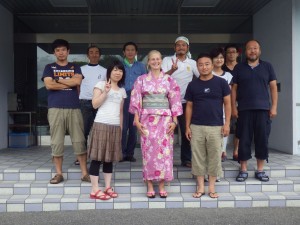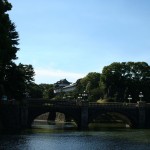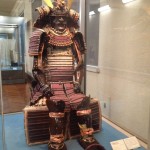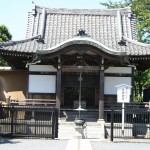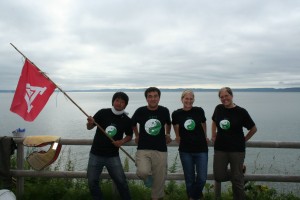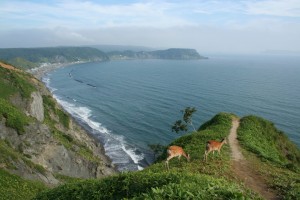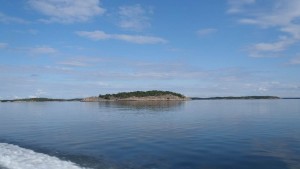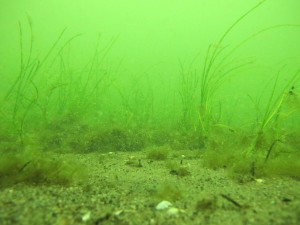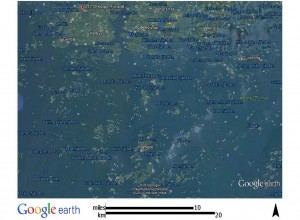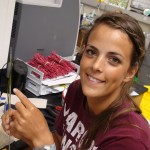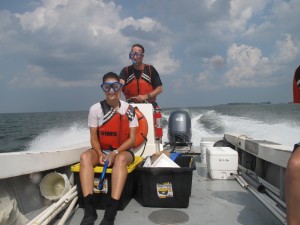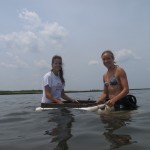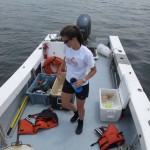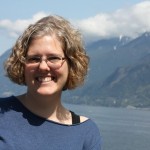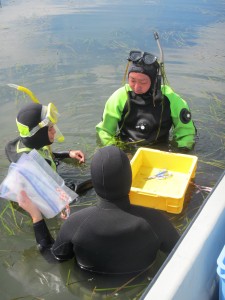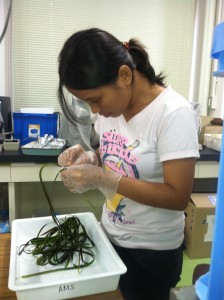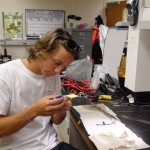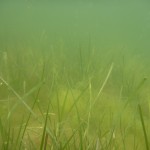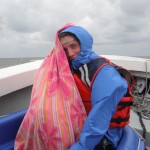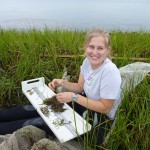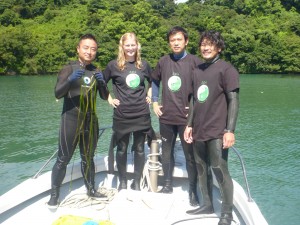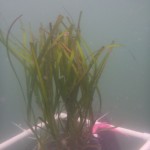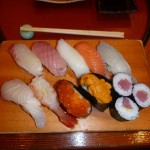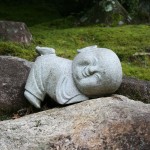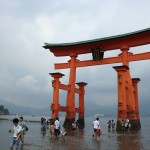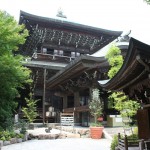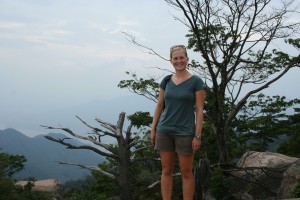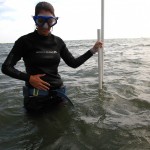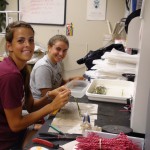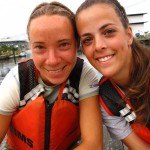Winged Grazers Mow Down Eelgrass in San Francisco Bay
By Pamela Reynolds (ZEN Coordinator)
Here at ZEN, when we use the word “grazer” we typically mean the small crustacean and gastropod invertebrates that live on and eat the algae (and sometimes the eelgrass) at our estuarine field sites. But for our partners at the Romberg Tiburon Center For Environmental Studies in California, grazers come with webbed feet, a hiss and a honk.
In San Francisco Bay migrating Canada geese mow down eelgrass beds and may help drive the persistence of separate perennial and annual growth forms within the same bed, says laboratory technician Stephanie Kiriakopolos who studied Zostera marina life history traits for her master’s thesis under ZEN partner Dr. Kathy Boyer at San Francisco State University.
Want to see the geese in action? Check out this video from Stephanie, and the nifty cages the San Francisco ZEN team constructed to keep these winged grazers out of our experiments.
Thankful for my day job
by Pamela Reynolds, ZEN Coordinator
This past week in the States we celebrated the Thanksgiving Holiday, which encouraged me reflect on all that I am thankful for – family, friends, and great colleagues near and far!
Continuing along the theme of creative collaborators, a film recently sent to me from grad student Ross Whippo in ZEN partner Dr. Mary O’Connor’s lab at the University of British Columbia in Vancouver, Canada, reminds me what a great career I have as a marine ecologist. What does your lab do?
Science is Creative
by Pamela Reynolds, ZEN Coordinator
Coordinating the ZEN is awesome. Not only do I have the opportunity to interact with incredibly smart and wonderful researchers across the globe, but I am constantly impressed with their creativity and talent. From writing marine ecological haikus to crafting algae and sea creature art, the ZEN partners continue to surprise me.
Here’s a video recently sent to me by Eduardo Infantes, a postdoc with Per Moksnes’ who assisted with the ZEN projects this past summer in Sweden. This video produced by Eduardo shows how the Swedish team used the experimental protocols and materials we sent them from VIMS to implement an experiment testing for predator effects in eelgrass beds at their field site in Gullmar Fjord. The video features Drs. Moksnes, Johan Eklov and Lars Gamfeldt, and grad student Jonas Thormar at the Kristineberg Marine Station on the west coast of Sweden. Just think how much shorter and more exciting scientific papers could be if they all included links to online video methods with fun soundtracks like this!
I’ll let Eduardo and some of the other ZEN scientists tell you in more detail about the experiment (affectionately called the “Podsicle” approach) in another blog post. Until then, enjoy the movie!
Sayonara Hiroshima, Konnichiwa Akkeshi
by Rachel Gittman (ZEN graduate fellow)
After nearly a month in Hiroshima, it was almost time for me to make my way to Akkeshi to help Dr. Nakaoka and Nicole Kollars, the other ZEN graduate fellow in Japan, process samples post-breakdown of the ZEN main experiment. The experiment tests the interacting effects of mesograzers and nutrients on seagrass ecosystem function through the use of a grazer deterrent rather than traditional caging techniques. Before I left Hiroshima we had one more experiment to run testing the roles of predators in local eelgrass beds, and then I was off to Tokyo for a few days with Hori-san.
Conducting assays to test the strength of predation by small fishes and crustaceans on mesograzers at our field site was a fairly straightforward process, but was particularly challenging when the tide was up and the current strong. We experienced both of these conditions during our last predation assay. The water was too deep for setting up the assay by snorkel, so Hori-san and Hamaoka-san completed the assay with SCUBA. Shimbukoro-san and I used snorkels to set and collect minnow traps, which provide data on the abundance and composition of the ambient predator community. We caught several small fish in each of the minnow traps, primarily gobies and rockfish, but we decided to conduct additional fish sampling using a modified seine to get a better representation of the fish diversity at this site.
On my last day in Hiroshima, the lab surprised me with a Yukata, a summer time kimono and a farewell dinner. The next morning as Dr. Hori and I headed to the airport, I grappled with the realization that my time in Hiroshima was ending. This was not an experience I was likely to forget, but I knew that I would genuinely miss my new friends.
Finding my way in Tokyo
Before heading to Akkeshi to help Dr. Nakaoka with the ZEN experiment’s at the northern Japan site, I spent a few days in Tokyo. Tokyo is overwhelming to say the least; just stepping off the train into Tokyo Station makes you realize how large and bustling of a city it really is. You could spend an entire day just in the train station with all of the shops and restaurants, but fortunately I had time to make it out of the station and see two of the major tourist attractions in Tokyo: the Imperial Palace and Ueno Park.
Although you can only enter the palace two times of the year (new Year’s day and the Emperor’s birthday) without a scheduled tour, just seeing the outside of the palace was worth the walk in the hot August sun. Ueno Park is a large park in central Tokyo that includes numerous museums, temples, shrines, and a zoo. Although I didn’t have time to see it all, I enjoyed the exhibits in the Tokyo National Museum and visiting the shrines and temples throughout the park.
Akkeshi: a different climate
From Tokyo I headed north to the town of Akkeshi where I would spend the next week assisting with the ZEN research. Compared to the fast pace of Tokyo, Akkeshi is like a different world. Akkeshi is a small, quiet fishing town on the Pacific coast of Hokkaido, the northernmost island of Japan. The marine lab where the northern Japan ZEN team was based is located just outside of Akkeshi, within a National Park.

ZEN graduate student exchange fellows Nicole Kollars and Rachel Gittman marvel at how tall the eelgrass is in Japan
After a warm welcome from Dr. Nakaoka, his wife, the lab and a minor earthquake (although it didn’t feel so minor to me), I jumped into sample processing. The fieldwork for the main experiment (see Nicole’s blog) was complete, but we had a lot of samples to process in a very short time. Although I had processed samples for ZEN in North Carolina before, sample processing in Akkeshi was a little different. Simply put, everything is just bigger in Akkeshi. The seagrass is bigger, the grazers are bigger, and, naturally, the epiphytes are bigger. Filtering the epibionta scraped from the eelgrass shoots was a challenge because of the large scale of all of the organisms.
Fortunately, because of the dedication of the lab, we were able to complete sample processing in the week that I was there and I still had time to hike to the top of the cape above the lab with Nicole and witness to breathtaking sunsets. We also made sure to sample some of the delicious ice cream made fresh from a local dairy just outside of town.
Before I knew it, it was time to leave Akkeshi, but not before we spent our last night eating sushi and celebrating with the lab at a wonderful local restaurant. Although my trip was not quite over, this was my last day working with the ZEN team in northern Japan. I truly enjoyed the experience and learned a great deal from our Japanese collaborators. Hands-on experience conducting multiple field experiments in entirely different environments (North Carolina, Hiroshima, and Akkeshi) was eye-opening for me and gave me a new perspective on collaborative research. I have tremendous respect for the ZEN partners all over the world trying to make this project a success in their own unique environments.
I’ll end the blog here, but see my and Nicole’s final joint-blog for the highlights from our travels in the land of the rising sun.
(Wet)Suiting up for research
by Paul Richardson (VIMS lab technician)
The Experimental Site
Just barely over my jet lag, we recently set up the main ZEN experiment at the Fårö Island eelgrass meadow in about 3 -4 meters of water a one hour boat ride from the field station in Korpoström. Unlike the warm shallow waters of the Virginia grass beds, all of the work was done in SCUBA with dry suits by Camilla, Anna and Christoffer. I assisted from the boat or in my 7mm wetsuit with snorkel gear.
The plots were staked out with short galvanized rebar rods instead of the PVC poles that make up our “pole gardens” in Virginia. For marking tags they ingeniously employed cut squares of linoleum flooring tabs. The site perimeter is marked by small buoys. Because the water is so deep at the field site, there is no worrying that a small boat will run over the plots.
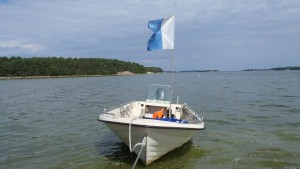
The research vessel used by the ZEN team in Finland. Note the blue and white dive flag. In the U.S.A., red and white flags are used to alert that divers in the water.
Witnessing the huge addition of logistical effort to conduct the ZEN work in deeper water with SCUBA and especially dry suits gives me a new appreciation for what the ZEN partners working at deeper subtidal sites have to do to get the job done. Everything takes at least twice as long. The work and general communication is more difficult. Work is limited by the air in the tanks, bottom time, and general fatigue. Once the work is done and everyone is out of their dry suits, they can’t just jump back in the water and fix something if needed. It usually takes another planned trip.
Algal Blooms!
Further complicating matters is the fact that the usually clear waters of the field site (see pictures from the 2011 experiment) have been clouded by a senescing blue green algae bloom that leaves the water full of chunks of a green, snot-like substance that you don’t want to swallow – apparently it is hazardous to your health. Also, the eelgrass beds are covered with a matrix of algae that are dominated by the frilly Ectocarpus. Otherwise, the eelgrass blades themselves are beautiful, green and covered with very few epiphytes. But these Ectocarpus mats are so thick that in places they go completely anoxic and turn white. We see similar effects during certain times of the year in Virginia where large blooms of the green algae Ulva and red Gracilaria drift in and smother the eelgrass in the Chesapeake. Here in Finland there is the danger that if you disturb these mats you can get a shot of hydrogen sulfide that can penetrate right through your skin.
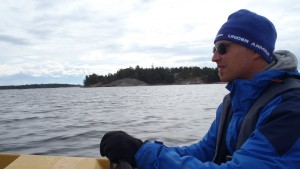
Christoffer Boström navigates the complicated seascape of the Archipelago Sea to the ZEN project site on Fårö Island, Finland.
Also, since the Fårö Island site is about 24 km away it requires an hour long boat ride. With fuel costing 1.63E/L (that’s $6,71/gal) and SCUBA setup and breakdown time, every field trip is a significantly greater investment of time and money than what I’m used to. Field days are usually 15 hour days. But once it’s all done I know it will all have been worth it.
According to the locals and everything that I’ve read, the Archipelago Sea has over 30000 islands! Being the experienced boat captain that I am back in the States, I can say that I won’t even attempt to navigate a boat around here. The gauntlet of islands on the way to the field site is mind boggling. I’ll leave the navigating and boat driving to Camilla, Marie, and Christoffer, who have the local knowledge and skills to safely transport us to and from the field site at Fårö Island.
Finnish News Media!
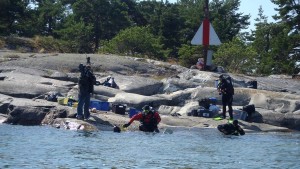
Journalists from the Finnish Nature channel film the ZEN team in Finland as they prepare to setup a large experiment
On top of everything else, we also had a visit from the Finnish news media. Christoffer brought them by boat to our remote field site shortly after the beginning of the work on the 13th. We were each interviewed for the national T.V. news, the radio, and the magazine, Suomen Luonto, which literally translated, means “Finnish Nature.”
It went pretty well, except that I gave the reporter some footage of us working in the grass beds of Virginia and I neglected to delete the audio which I didn’t think would be included, but it was. Also, in my jetlagged state, I mentioned that prior to the human perturbations in the Chesapeake Bay, “there was 90 % more (sea) grass in the Bay,” which, if taken out of context is not exactly correct. The seagrass coverage that we have now is 10% of historic levels. In other words, seagrass coverage in the Bay was historically 900% of current levels! Either way you look at it, that’s a huge and worrisome decline given all the important ecosystem services and functions that seagrasses provide. Media exposure can be good for your cause, but I’m finding it can also be difficult. Anyhow, overall, I think we got the message across that eelgrass meadows are important systems all over the northern hemisphere and that they need to be protected. Check out the ZENscience news page for a link to this story.
Memorable moments in Virginia
by Katelyn Jenkins (College of William and Mary undergraduate student)
Many of the jobs I’ve tackled this summer have surprised me. I would not have guessed that I would become a PVC cutter, plaster block-maker, wire bender, mesh cutter, or sewer. However, I have learned that it takes a lot of skills, laughter, and water (often with a dash of Gatorade!) to prepare for such large-scale experiments in marine ecology. Through spending days of cutting many pieces of PVC and the messy job of making plaster blocks, I have enjoyed this job because of the new friends I have made in the MBL lab. From having numerous nicknames to help distinguish myself from the lab’s REU (also a Caitlin), to dancing on poles marking experimental cages in the field, this summer has been a great one to remember.
When I am not counting PVC or cutting wire, I have taken over the job of transferring seagrass samples from various ZEN partner sites to reinforced vials to grind down for nutrient (carbon and nitrogen) analysis. To do so, I have to go to William and Mary’s main campus to use a machine that will grind the samples (affectionately known as “Shakira” by its owner, Dr. Kerscher, who graciously allows us to use his lab space). The first few times I went to the main campus to grind the samples, the machine was placed in a lab. However, all of the large samples from partner sites makes for a very tired and warm ‘Shakira’. To resolve this, I planned to take breaks between sample grinding during my next visit. But, when I arrived on campus weeks later in almost 100° F weather in my shorts and t-shirt, I had no idea the machine was being moved to a cold room of 34° F! Though the initial “air conditioning” felt much needed, I quickly found myself freezing (literally) while trying to grind my samples. With multiple “defrost-Katelyn” steps inserted into the protocol (which involved running outside into the muggy Virginia heat until my fingers had thawed), I was able to successfully grind all of the samples. I can now say that I always come prepared with full gear to face the cold room. You can easily spot me walking across campus as I am the only one with a big jacket and pants in the middle of summer!
Aside from the strange climactic working conditions, I spend a lot of time in the field – one of my favorite parts! I have learned to master “Snorkeleese”, the language when talking with a snorkel in your mouth and your face down in the seagrass bed. “Ooo uoooo eeeddd elpppp?” translates easily to “Do you need help?” and “ablee eye eeese” almost always means “cable tie please”. All joking aside, most importantly I have had the chance to snorkel in the Goodwin Islands and see tons of marine life, all while learning the ins and outs of getting experiments set-up and broken-down in the field.
After taking a Marine Ecology course at William and Mary, it has been very exciting to see a lot of the things that I have read many papers on. For example, I read many papers on seagrass beds and algal blooms in the Bay and it is very interesting to see these different topics hands-on. One of the most interesting experiences I have had with marine life during the ZEN project was during the break down phase. While riding from our field site back to VIMS, about 15 dolphins began to swim around us as they searched for food. It was very exciting to see these animals so closely, especially because I have never seen so many in the York River before! Aside from this, I have had the opportunity to see tons of crabs, fish, and even sting rays!
Overall, this summer has been an incredible experience that has taught me many valuable skills. I can’t wait to see what lies ahead!
ZEN – a truly international effort
by Nicole Kollars (ZEN graduate research fellow)
“Many hands make light work.”
I like this quote from John Heywood. With the breakdown for the main ZEN experiment in Akkeshi quickly approaching, I became nervous that with only four pairs of field hands we would not be able to accomplish all of the necessary sampling in a timely manner. When I helped break down the ZEN site in North Carolina early this summer we had a small army of seven collecting field samples, removing the experimental materials, and processing the samples. And in North Carolina we were all native English speakers, which streamlined field communication. But, during my time working with the ZEN team in northern Japan I have been constantly reminded that even just a few well-coordinated hands can make a massive amount of work manageable. The breakdown was no exception.
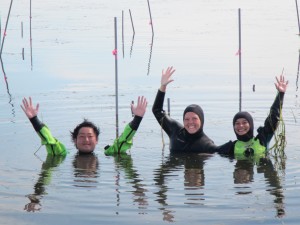
Kyosuke, Nicole, and Dr. Khwan Whankpetch during the breakdown of the ZEN experiment in Akkeshi, Japan
With 3 people in the water and 1 person on the boat handing out supplies and organizing the samples, we managed to break down the site in a smooth and efficient manner. Despite our relative lack of numbers, we managed to complete the experimental breakdown with its numerous sample collections in just two trips to the field site. I was amazed by this – not because we completed the work, but because we came to the field from four different countries. A Japanese (graduate student Kyosuke Momota), an American (me!), a Thai (visiting scientist. Dr. Khwan Whankpetch from Kasetsat University, Thailand) and a Filipino (visiting prospective student Venus Leopardas) all united together under the common mission of the Zostera Experimental Network – to produce great science.
The language barrier certainly posed a stumbling block in communicating with one another. This was especially challenging when difficulties arose and we had to work together to come up with a solution or when we were trying to find the best way to divide the work. It is a humbling experience for me because even though I am the foreigner to this country, communication is catered to my native tongue and we speak to each other in English. I wish I could say that I have learned more Japanese during my time here. I’ve mastered niceties such as “good morning” (ohayou gozaimasu) and “thank you” (arigato gozaimasu), but a full conversation is not possible – yet.
I continue to be astonished by how many languages the people I have met here not only understand but speak and read. For example, not only does Khwan speak Thai but she is also fluent in Japanese and English. Then there is the matter of the Japanese characters. In addition to learning the English alphabet, Japanese children learn three different sets of characters: hiragana, katakana, and kanji – there are over ONE THOUSAND characters in total! I have only mastered one – the “on” button for the washing machine.
Communicating in the field
Despite the language difficulties, we have learned to anticipate what one another needs and to find creative ways to express ourselves. By choosing our words carefully and speaking clearly we can usually get our point across. However, it is not to be underestimated how much you can say without saying anything at all. Through my experiences here in northern Japan I have come to realize how important thoughtful gestures and facial expressions are in average day to day communication. A smile definitely goes a long way! I have also found the ZEN experimental manual composed by Drs. Reynolds and Duffy to be invaluable. We use it both as a reference for the experimental procedures and as a tool for pointing out questions and providing answers. The methods videos accompanying the manual are also great as they show techniques that can be hard to explain even when everyone speaks the same language.
With all of the samples collected from the field, our attention turns back to the lab where the sample processing has begun. Kyosuke and I have been grateful for the help of Khwan and visiting researcher Ms. Venus Leopardas (Mindango State University at Naawan in the Phillipines). We are sad to see them leave as they return to their home countries, but we are happy to welcome ZEN student exchange fellow Rachel Gittman and undergraduate intern Ms. Minako Ito (Hokkaido University) to the Northern Japan team as we finish processing this week. It is great to be reunited with Rachel after working with her at the ZEN site in North Carolina. Stay turned for our upcoming co-authored blog entry “North and South unite!” There we will highlight our last week here in Akkeshi and our experiences as we travel across Japan before returning home. It’s incredible to think that our 6-week adventure is almost at an end!
The business of science
by John Schengber (VIMS undergraduate student summer intern)
I am an undergraduate at James Madison University and have been working this summer with the ZEN team at the Virginia Institute of Marine Science in Gloucester, Virginia. I have lived right across the river in neighboring Yorktown for most of my life. Surrounded by nature and adventure, I have become an outdoor kind of guy with an intense curiosity and respect for nature. I still have not decided the exact career path I want to take, so this summer was an excellent opportunity to explore research and marine biology.
I think most people in the lab were surprised when I revealed that I am in fact a business major. Everyone else around here studies (go figure) science. In the fall, I will be returning for my sophomore year at James Madison University, where I am pursuing a major in International Business coupled with a double minor in Spanish and Environmental Science. Now, why in the world would a business major be working in a science lab? First, let me emphasize that this career direction is not entirely definitive for me. I am fascinated by a myriad of fields of study. In business, I am drawn to the ideas of entrepreneurship and creativity, but not so much to the possibility of cubicle entrapment. I dream of running my own company, but am conflicted as business/industry can often be a driving force in the destruction of our natural world.
My love for science stems from my love for nature and the questions it begs us to answer. I am in constant awe of its wonder, and my life would be at loss if my studies lacked a good dosage of the biological sciences. Yet I love to interact with people (especially in Spanish), to solve problems, and to try new ideas in the business sector. So, I have come to a crucial intersection of interests. Business seems to be the last thing to enter if one is focused on saving the world from its own ruin. But I wonder if it can be done differently? Can we make a business that is not just sustainable but truly symbiotic with our environment? Most importantly, can this venture be profitable in a cut-throat capitalist economy? Lastly, can I be the person to do this? I have no idea. But I’d say it’s worth a shot.
So here I am at the Virginia Institute of Marine Science taking that first step. I came into this position with a few hopes and expectations. I wanted to check out the work of a marine biologist, which is my greatest love in science and the field that I would most likely enter if I decided to pursue a research career. I hoped that I would meet some incredible people with inspiring intelligence and personalities to match. I wanted to view the process of scientific investigation from beyond classroom instruction or media coverage. I wanted to learn a lot and experience even more. But really I just wanted to hang out with some amphipods.
All of my hopes and expectations have been fulfilled, and I have loved every minute of it. I have made new friends and linked up with old ones (see Nicole Rento’s post, fellow lab member this summer and best friend since, well, forever). I have learned more than I could have ever imagined. I have spent some quality time with lots and lots of amphipods. And I’ve learned that running a lab really isn’t too much different than running a business. There are budgets, deadlines, management, and lots and lots of ingenuity. Maybe there’s hope for me yet.
Science and Site Seeing in Hiroshima
by Rachel Gittman (ZEN graduate student fellow)
Even though I have only been in Japan for three weeks, I am really beginning to feel a sense of home here. I have experienced so much since my last blog, but the most rewarding experience has been becoming part of the marine lab here in Hiroshima. Hori-san, Hamaoka-san, and Shimabukuro-san as well as the other members of the lab have made me feel both welcome and comfortable. We have lunch and afternoon tea together each day and although I am still struggling to communicate at times (I wish I could say my Japanese is improving, but I haven’t really gotten past basic greetings and responses), I am learning so much.
We have been very busy over the last few weeks with two ZEN experiments – a short term assay to examine the intensity of predation on mesograzers and a longer experiment to examine predator effects on the seagrass community. Thanks to the hard work and dedication of the lab, all of the experiments have been running smoothly thus far. After a week of cage building, we were ready to set up the longer predator exclusion experiment. Setting up the experiment here is a little different than setting it up in Virginia or North Carolina because our site is entirely subtidal and it gets pretty deep when the tide rises.
Hori-san and Shimbukoro-san used SCUBA to set the cages, while Hamaoka-san and I snorkeled above them, holding our cages on a long rope leash. The entire set-up took about six hours and I was able to capture about half of the set-up in a timelapse from shore.
Although we have been busy with our field experiments, the lab was kind enough to take me out for my birthday and gave me a great birthday present: cake and my own house shoes (very important to have in Japan). It was a wonderful birthday surprise and I am glad I was able to spend my birthday in Japan.
I share my birthday (August 6th) with the anniversary of the a very tragic day in history, the detonation of Little Boy, the first atomic bomb used in World War II. I was able to visit the Atomic Bomb dome, the remnants of the government building that was almost directly below where the detonation occurred, and the Peace Memorial Park. Visiting those sites was a humbling but positive experience because of ongoing efforts by the Japanese people to encourage world peace.
Beyond just seeing the sites, visiting Japan has also been about the experiences and more importantly the food! After much anticipation on my part as an avid sushi-lover, my hosts took me to a Japanese sushi restaurant in Hiroshima City. I could hardly contain my excitement as we sat down to order at the sushi counter. We had a perfect view of the chefs preparing the sushi and I was determined to try everything. Needless to say, I was not disappointed. The sushi was amazing and included some items that were new to me, such as squid, octopus, and urchin. The atmosphere, food, and my new friends made the night one that I am not likely to forget.
I can’t end the blog without sharing a few more of my site seeing adventures.
Over the weekend and this past week, I had the opportunity to visit some of most beautiful and historic places in this part of Japan: Miyajima and the Iwakuni Kintai bridge, in addition to the peace and atomic bomb memorials in Hiroshima City. Miyajima is a World Heritage Site just a few kilometers and a short train and ferry ride from the FRA Institute. The island contains many historic sites, including the Otorii Gate, Itsukushima Shrine, and Daishoin Temple, as well as nature trails that lead to the top of Mt. Misen.
After exploring the temples, shrines, and the public aquarium I decided to hike to the top of Mt. Misen to get a good view of the area. Along the way, I happened to meet a fellow North Carolinian, and we decided to hike up together. It was a good choice, because the 3km hike was very steep and the humidity and heat made reaching the top quite an accomplishment. The view was worth it though and the descent was much more pleasant.
I want to save some of my site seeing for another blog post, but I will briefly mention the Iwakuni Kintai bridge. Built in the early 1600s, it was deemed “indestructible” because of the superior engineering design and construction, well ahead of its time. The bridge is not only impressive from an engineering perspective, it is also incredibly beautiful. Although the bridge was partially destroyed in the early 20th century, it was restored to its original glory a few decades later and it still maintained in its original design and structure. Seeing the bridge just as the sun set was worth the wait. Having to wait for it to get dark also meant I could get more ice cream – this time I went for mango. I am pretty sure I have eaten more ice cream here in the past three weeks than I have for all of last year. What can I say except that it is just delicious!
The start of something new
by Katelyn Jenkins (College of William and Mary undergraduate)
My name is Katelyn Jenkins and I am a lab technician here at the Marine Biodiversity Lab at the Virginia Institute of Marine Science in Gloucester Point, Virginia. This year I will be a junior at the College of William and Mary where I am majoring in biology and minoring in marine science. As a local from Yorktown, Virginia, I have become fascinated with the environmental and economic importance of the world’s largest estuary just down the street – the Chesapeake Bay.
I became involved in research at VIMS during high school in 2008 where I worked in a Marine Conservation and Biology lab. Immediately immersed into field and laboratory work, I knew right away that marine science was a field I wanted to pursue. During 2009-2011 I began working on a research project at William and Mary that aimed to identify and characterize a harmful bacterium recently identified in striped bass in the Chesapeake Bay. Although the topic excited me, it wasn’t until I spent 2 years indoors running multiple PCR’s day after day in the lab that I knew I needed to get back into VIMS where I could study marine science on a much larger scale. In 2011, I began volunteering for Dr. Emmett Duffy in his Marine Biodiversity Lab where I learned to identify various types of seagrass, algae, and LOTS of what we affectionately call ‘bugs’ (small marine invertebrate grazers). Recently I put these new skills to the test when I returned to the lab to work as a technician for the summer.
This summer began on a busy note. I arrived at VIMS the day after I returned from a field course on the Eastern Shore. I had just enough time to unpack before I needed to repack my bags to head to Beaufort, North Carolina with our lab manager Paul Richardson to break down an experiment with the ZEN team at the University of North Carolina’s Institute of Marine Sciences (IMS). It was an exciting trip where I had the chance to meet and work with Erik Sotka and his lab group from the College of Charleston in South Carolina in addition to local NC graduate and undergraduate students. My first field experience with this lab group was an exciting one – there is a broad diversity of research projects and techniques employed in the ZEN. One of my favorite parts of the trip was having the chance to stay and work at IMS as well as learn about the ongoing research at this facility, as I have been thinking about potential graduate schools and programs to pursue after graduating from William and Mary.
After returning to VIMS, I have been involved in helping with many projects and picked up new skills: plumbing, sewing, processing chlorophyll samples, taking and sorting biomass cores, and preparing leaf tissue samples for CHN analysis. Although it may seem busy, it has forced me to become mentally organized with all of the different things going on in the lab – something that I think is a very important ‘life skill.’ I have also found that I have gained a lot of confidence in my abilities to recognize what needs to be done, when it needs to be completed by, and what needs to be done to have it completed. There’s a lot more to science than just doing research. I’ve learned that the planning, management and constant juggling of tasks is just as important as actually processing samples.

